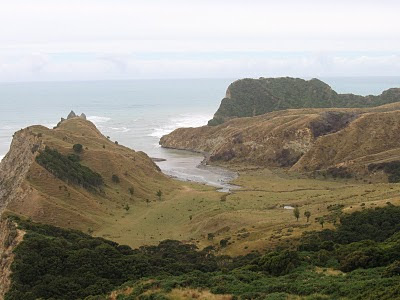Up early to begin the tramp - and straight into the Makaretu Stream which we followed for several hours, crossing and recrossing. No paths here! So wet feet all day (standard practice in the Tararuas):

Near the start we entered a gorge where there had recently been a big rock slide. Quite deep here and so we had to wade over waist deep with packs held high!:

Had this little visitor. A weta:
 This one hitched a lift on someone's pack and appeared at our next stop. They are big, about 10cm, but harmless:
This one hitched a lift on someone's pack and appeared at our next stop. They are big, about 10cm, but harmless:http://en.wikipedia.org/wiki/Weta
Here we are among lichen covered rocks about to head straight up through the bush to the Oriwa Ridge. We passed a hunter's bivvy (camp and shelter) and saw evidence of the pigs and goats they were after:

It was a hard day, good to be out of the stream, but a tough climb up with 15kg on your back! At the top there was a rainwater collector and a flat area for camping. We moved out of the trees as it was colder there, however in the night the wind got up and we got a bit damp:
 Next day wet boots back on (fine after a few minutes) and a tramp along the ridge then down requiring lots of careful navigation using maps, compass, altimeter and a check with the GPS. More stream crossing followed as the waters were high and we had to alter our route:
Next day wet boots back on (fine after a few minutes) and a tramp along the ridge then down requiring lots of careful navigation using maps, compass, altimeter and a check with the GPS. More stream crossing followed as the waters were high and we had to alter our route: The day's walk ended 12 hours after leaving our camp! We reached the packed hut at Waitewaewae:
The day's walk ended 12 hours after leaving our camp! We reached the packed hut at Waitewaewae: However spaced was made for us and we finally sat down to dinner at about 10pm! Sleeping under a real roof, luxury! Outdoor canine accommdation also provided:
However spaced was made for us and we finally sat down to dinner at about 10pm! Sleeping under a real roof, luxury! Outdoor canine accommdation also provided: Great tale from a chap about trying to move the toilet building from the old hut site by river rather than carrying it along the muddy track - it promptly sank and had to be hauled out again! The last section of the walk followed an old tramway used to transport logs. The steam engine that was used to haul them down to the rail head still there:
Great tale from a chap about trying to move the toilet building from the old hut site by river rather than carrying it along the muddy track - it promptly sank and had to be hauled out again! The last section of the walk followed an old tramway used to transport logs. The steam engine that was used to haul them down to the rail head still there:
At the very end we crossed the Otaki river on this amazing bridge:

Another good day - only 5 hours of walking and then back to Wellington via a chocolate stop at a garage!
Wading the Makaretu:








































